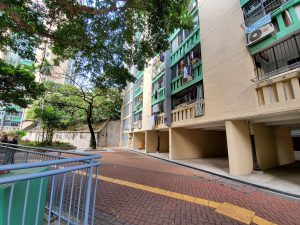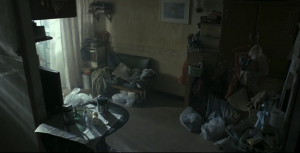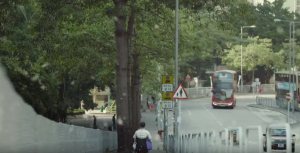STILL HUMAN, DIR. CHAN SIU KUEN (2018)
OI MAN ESTATE, Ho Man Tin, Hong Kong
The film ‘Still Human’1 tells a story about how the two protagonists overcoming their plights in Oi Man Estate. Leung Cheong-wing was once a construction worker, but he is paralyzed because of an accident. Due to his disability, his family fragmented. He blames himself and feels hopeless about his future. Evelyn applies to be Cheong-wing’s domestic worker because she wants to escape from the troubles in finance and marriage. It is touching that with the support from one another, Evelyn becomes a photographer, and Cheong-wing lives with his son again.
Both similarities and differences exist while comparing the scenes in the film to reality. Oi Man Estate in the film looks the same as the real one, but the color tones of some shots are altered. Inside Sun Man House, the corridors are much dimmer than usual. The light only comes from the sky, the upper opening of the patio between the four walls. The sky is much bluer and brighter while standing and looking at it from the bottom of the building. A warm filter is used when Cheong-wing and Evelyn enter and leave the estate through the slope.
Not much change is made while filming Oi Man Estate. Due to the well-like design of Sun Man House, the interior flats receive little light. The four concrete walls put stress on the residents that it seems the residents are prisoned. It denotes that Cheong-wing and Evelyn living there have no hope to escape the prison. The inside of Cheong-wing’s flat is dark and untidy. This shows that Cheong-wing is dispirited and has no motivation to live better. To them, Oi Man Estate is not only a place but a space with memories and perceptions. Cheong-wing has lived there before he got injured, so he treasures the experience of living with his son and wife there. In Oi Man Estate, Evelyn makes her dream true because of Cheong-wing’s care and help. Due to these remarkable memories, they value and love the estate. Oi Man Estate is just a living place for most of the residents, but it is the place where Evelyn starts to chase her dream. She took many photos there with the companion with Cheong-wing. The estate has more than one meaning to Evelyn. Flowers and cotton from the cotton trees appear frequently in the film. The flowers drop from the trees and lie on the floor. It signifies although Evelyn is facing obstacles, she has the power to overcome them and the talent to be a photographer, just like the flowers. Cotton falls from the cotton trees and floats in the air. It signifies Evelyn can only grow and gain success by leaving her comfort zone. The warm color tone used signifies the pure relationship between Cheong-wing and Evelyn and the hope in life. Cheong-wing lends a hand to Evelyn without considering himself. He just wants to help Evelyn to achieve her goals. Similarly, Evelyn takes care of Cheong-wing because she wants Cheong-wing to be confident again. The unconditional help from each other let them be energetic and optimistic about the future.
— Poon Ho Ting, 3035800904

- View of the park next to Oi Man Estate in 2021


Left: View of the inside of Cheong-wing’s flat in Sun Man House. Scenes from Still Human, 2018, directed by Chan Siu Kuen. Right: View of the patio of Sun Man House. Scenes from Still Human, 2018, directed by Chan Siu Kuen.


Left: View of the slope next to Oi Man Estate. Scenes from Still Human, 2018, directed by Chan Siu Kuen. Right: View of the cotton floating in the air. Scenes from Still Human, 2018, directed by Chan Siu Kuen.
Notes;
- Produced by No Ceiling Film, the film was directed by Chan Siu Kuen and starred Hong Kong actor Anthony Wong. It was released in Hong Kong in November 2018.
Good attempt to compare the aesthetics of the movie with your observations from the field trip via filming techniques. It would be helpful if you have more visual documentation from your field work to illustrate your detailed description in your comparative analysis. I understand that it might be difficult to document the domestic spaces but the common areas could have been included. Appreciate that you’ve mentioned the movie uses everyday spaces as narrative, you may wish to borrow ideas from de Certeau’s Walking in the City from L4.
a minor point to note: there were a few typos in the text, for instance – “well-lit” design instead of “well-like”.